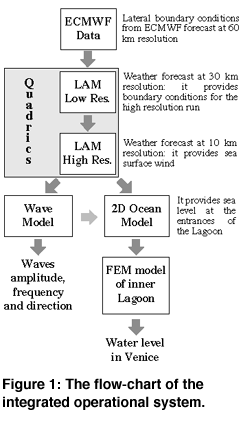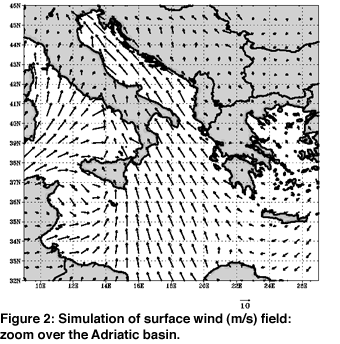A High Resolution Integrated Forecast System for the Mediterranean Sea
by Andrea Bargagli, Roberto Iacono, Sergio Nicastro, Paolo Michele Ruti
and Franco Valentinotti
An integrated atmosphere-ocean forecast system, covering the whole Mediterranean basin, is being developed at ENEA (Italian National Agency for New Technologies, Energy and the Environment). The project, sponsored by the Department of Technical Services of the Italian Government, has two main goals: the high resolution forecast of the state of the Mediterranean Sea (in terms of surface wind, wave height and direction) and the prediction of flooding events in the city of Venice. The operational forecast system, which will be completed by mid-1999, will provide a useful tool for Civil Protection and, possibly, for other institutions involved in environmental surveying, coastal protection, navigation control and harbour management.
 The integrated
atmosphere-ocean forecast system for the Mediterranean, which is now being
developed by the group for Atmosphere-Ocean Dynamics at ENEA, is shown
in Figure 1. Predictions of the amplitude, frequency and direction of the
sea-waves are obtained from a spectral wave model, while a two-dimensional
grid-point model of the Adriatic Sea circulation, coupled with a shallow
water, finite element model of the Lagoon, is used to predict the sea level
in Venice. Both the wave and the ocean models are forced by the surface
wind stress computed, at very high resolution (10 km), by a 3D meteorological
Limited Area Model (LAM) running over the whole Mediterranean basin.
The integrated
atmosphere-ocean forecast system for the Mediterranean, which is now being
developed by the group for Atmosphere-Ocean Dynamics at ENEA, is shown
in Figure 1. Predictions of the amplitude, frequency and direction of the
sea-waves are obtained from a spectral wave model, while a two-dimensional
grid-point model of the Adriatic Sea circulation, coupled with a shallow
water, finite element model of the Lagoon, is used to predict the sea level
in Venice. Both the wave and the ocean models are forced by the surface
wind stress computed, at very high resolution (10 km), by a 3D meteorological
Limited Area Model (LAM) running over the whole Mediterranean basin.
To satisfy the operational requirements (ie, a few days of forecast in a few hours), the meteorological model, which is by far the most demanding in terms of the computational effort required, was implemented on APE100/Quadrics, a massively parallel computer with a peak power of 25 billion floating point operations per second in the maximal 512 processors configuration.
In the operational configuration, an intermediate resolution run of the atmospheric model is performed, with a grid spacing of 30 km. This run takes initial and boundary data, at a 60 km resolution, from the global weather forecast produced every 6 hours by ECMWF (European Centre for Medium-Range Weather Forecasts) and provides the input data for the high resolution run of the LAM.
The wave model, which describes the evolution of the wave spectrum by solving the wave energy transfer equation, runs over the whole Mediterranean Sea at a constant resolution of about 30 km. On the other hand, the ocean model, computing the sea elevation at the entrances of the Lagoon, uses a variable resolution grid covering the Adriatic Sea, with grid size decreasing when approaching Venice.
Finally, a finite element, very high resolution model of the interior of the Lagoon is used to predict the water level in Venice. The mesh used by this model consists of about 7500 elements, with a spatial resolution varying from 1 km along the mud flats down to 40 m inside the channels.
 Several experiments, performed to
test the system performance, showed good agreement with observed data.
As an example, we show the forecast of an extreme surge, which took place
during November 1996, due to a strong cyclonic circulation over the Western
Mediterranean region. A maximum sea surface elevation in Venice of about
1 m, very close to the measured one, was predicted for the 18th, at 6.00
am. In Figure 2, we show the corresponding wind field, as predicted by
the meteorological model. A depression, initially located over Spain, has
moved towards the East, causing the pressure gradient to align with the
main axis of the Adriatic Sea, and therefore contributing to the sea level
set-up in the northern part of the basin. Surface wind is driven by the
surrounding orography and is directed along the same axis, blowing from
the South-East.
Several experiments, performed to
test the system performance, showed good agreement with observed data.
As an example, we show the forecast of an extreme surge, which took place
during November 1996, due to a strong cyclonic circulation over the Western
Mediterranean region. A maximum sea surface elevation in Venice of about
1 m, very close to the measured one, was predicted for the 18th, at 6.00
am. In Figure 2, we show the corresponding wind field, as predicted by
the meteorological model. A depression, initially located over Spain, has
moved towards the East, causing the pressure gradient to align with the
main axis of the Adriatic Sea, and therefore contributing to the sea level
set-up in the northern part of the basin. Surface wind is driven by the
surrounding orography and is directed along the same axis, blowing from
the South-East.
Partners in the project are FISBAT-CNR of Bologna, the University of Padua and ISDGM-CNR, Venice.
Please contact:
Andrea Bargagli - ENEA Rome
Tel: +39 06 3048 6416
E-mail: andrea@mantegna.casaccia.enea.it
